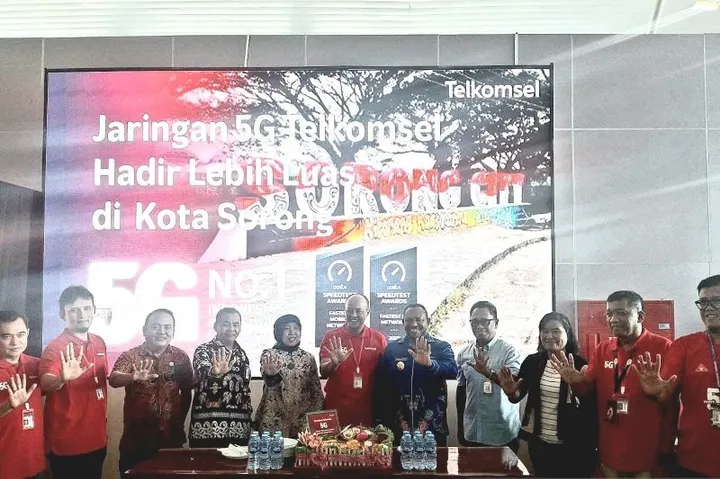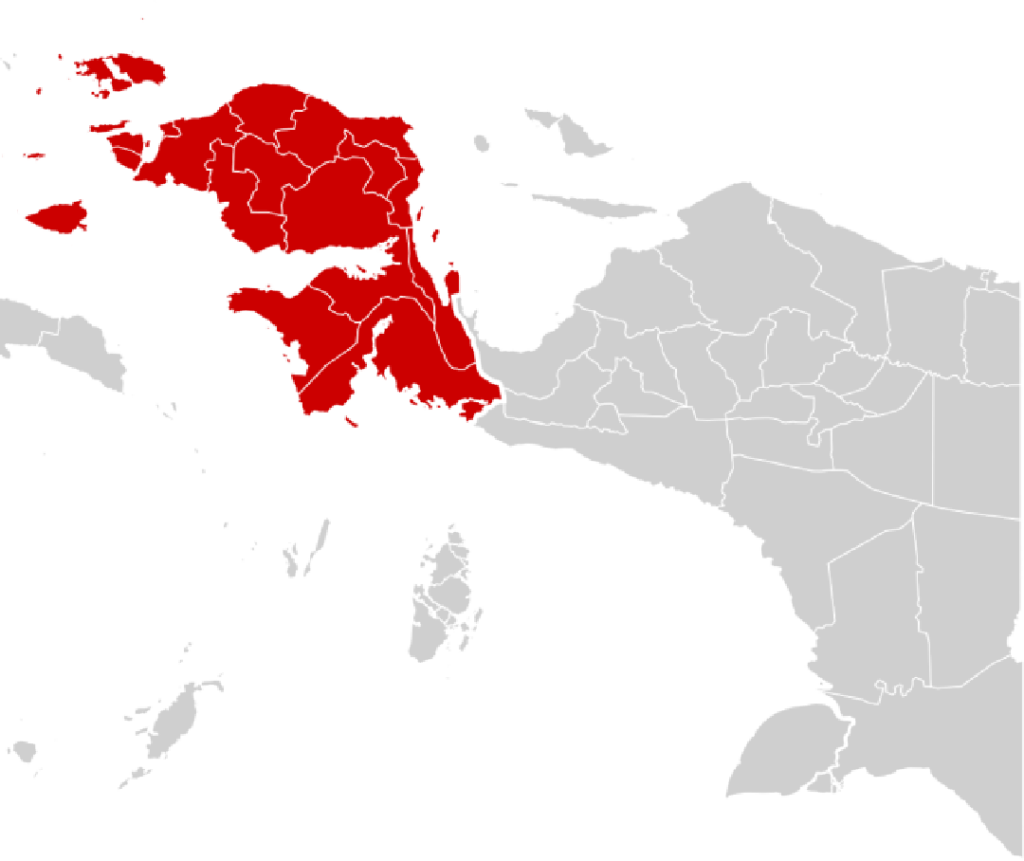The roar of airplanes taking off from Domine Eduard Osok (DEO) International Airport in Sorong was joined by another kind of excitement on October 24, 2025. This time, it was not the sound of engines but the pulse of progress—the launch of Telkomsel’s 5G network, the first of its kind in Papua Barat Daya (Southwest Papua). For a province often characterized by its geographical isolation and uneven infrastructure, the debut of this ultra-fast network signals a new chapter in connectivity, digital inclusion, and regional development.
The official launch ceremony, held at the DEO Airport, gathered local government leaders, business figures, and Telkomsel executives in a moment that many described as historic. Vice Governor Ahmad Nausrau, representing the Provincial Government of Papua Barat Daya, described the initiative as more than a technological upgrade—it was a leap toward equality. “With this 5G network, our commitment to making Papua Barat Daya the main digital gateway in the Land of Papua is strengthened,” he said, emphasizing that technology should serve as the great equalizer between western and eastern Indonesia.
For the hundreds of attendees, the message was clear: 5G is not just about speed—it is about opportunity. In a world increasingly defined by digital access, this milestone represents the first tangible step toward transforming the province’s economy, governance, and quality of life.
The Journey Toward a Digital Frontier
For years, Sorong has served as the logistical and economic nerve center of western Papua. It’s the entry point for goods, travelers, and now—digital innovation. The choice of Sorong as the first 5G site in the region is both strategic and symbolic. Telkomsel, Indonesia’s largest telecommunications provider, identified the city’s growing population, emerging tourism sector, and infrastructure readiness as key enablers for early 5G deployment.
The rollout began with three major locations: Domine Eduard Osok Airport, Paragon Mall, and Hangout Avenue. These hubs were chosen for their high public interaction and visibility—ideal settings to showcase 5G’s potential to local residents, travelers, and entrepreneurs. During the trial phase, the network recorded impressive speeds of up to 400 Mbps, delivering ultra-low latency and real-time responsiveness—an experience that left first-time users astonished.
“We wanted to bring Papua Barat Daya into the same conversation as major urban centers in Indonesia,” said Yasrinaldi, Telkomsel’s General Manager for Eastern Indonesia. “The goal is to ensure that no one, regardless of geography, is left behind in the digital transformation.”
Bridging the Digital Divide
For many in Papua, internet connectivity has long been a tale of uneven access. While coastal and urban areas enjoy stable networks, inland communities remain trapped in “blank spots” where communication is unreliable or nonexistent. The arrival of 5G promises to close that gap, starting from Sorong and gradually extending to surrounding districts.
Vice Governor Nausrau highlighted this aspiration in his speech: “The most important thing is not that we have 5G in the city, but that it must eventually reach every kampung. Communication should no longer be a privilege of a few—it must be a right for all.”
Telkomsel echoed that vision, outlining a phased expansion plan that includes strengthening existing 4G infrastructure while deploying new 5G base transceiver stations (BTS) in remote areas. The company’s engineers face a daunting task—terrain challenges, limited power grids, and expensive logistics—but officials remain confident that this digital mission will succeed, supported by the central government’s commitment to equitable development across Indonesia.
5G and the Promise of Economic Transformation
The arrival of 5G in Sorong is poised to reshape the economic landscape of Papua Barat Daya. Faster and more stable internet means smoother operations for small and medium enterprises (SMEs), greater efficiency for logistics and fisheries, and new avenues for tourism promotion.
Local entrepreneurs are already optimistic. At Hangout Avenue, a popular meeting point in downtown Sorong, café owners see 5G as a game changer. “Tourists can stream, share, and work faster,” said one owner. “It means more visitors will stay connected, post their experiences, and promote Sorong to the world.”
In the industrial sector, high-speed connectivity can optimize port operations, enable real-time shipment tracking, and improve coordination in oil and gas exploration—a cornerstone of the region’s economy. Meanwhile, local startups are beginning to explore possibilities in digital creative industries, remote education, and online marketplaces, all of which can thrive under robust 5G infrastructure.
Economists project that with proper adoption, digital connectivity could add hundreds of billions of rupiah to Papua Barat Daya’s regional GDP in the coming decade. But the true impact, they argue, will be measured not only in numbers but in the creation of new opportunities and livelihoods.
Strengthening Public Services and Education
Beyond economic growth, the 5G network promises to revolutionize how government and public institutions operate. With faster data transmission and greater bandwidth, local authorities can now explore smart governance models—integrating surveillance systems, traffic monitoring, and digital documentation. This digital leap can make administrative processes more transparent, efficient, and citizen-focused.
Education, too, stands to benefit enormously. Many schools in Papua struggle with limited access to online resources. Through 5G, students and teachers could participate in live virtual classrooms, download educational content instantly, and collaborate with peers across Indonesia. The provincial government has already announced plans to introduce 5G-based digital learning centers in partnership with Telkomsel’s corporate social responsibility (CSR) initiatives.
Healthcare access is another critical frontier. With improved connectivity, telemedicine can finally become viable in the region, allowing rural clinics to consult specialists in real time—something previously hindered by unstable connections.
Challenges on the Road Ahead
Despite the optimism, deploying 5G in Papua Barat Daya is not without hurdles. Infrastructure gaps remain the primary challenge. The mountainous terrain and remote islands make it costly to install fiber-optic backbones and maintain base stations. Power supply remains inconsistent in several rural zones, and transporting equipment across rugged terrain or via sea routes often takes weeks.
Moreover, device affordability is another concern. To enjoy 5G services, users need compatible smartphones and updated SIM cards—requirements that may not yet be accessible to all residents. Telkomsel has begun educational campaigns to help consumers understand how to activate 5G and has partnered with phone vendors to offer discounts on eligible devices.
Experts warn that without simultaneous efforts in digital literacy and infrastructure, the benefits of 5G could remain concentrated in urban areas, exacerbating the very inequality it seeks to solve. Thus, a coordinated effort between government, private sector, and civil society is crucial to ensure that 5G’s promise becomes a shared success story across Papua.
Local Reactions: A Sense of Pride and Possibility
As the 5G signal went live at DEO Airport, travelers and citizens experienced firsthand what ultra-fast connectivity feels like. “The difference is incredible,” said Yulius, a local passenger. “Streaming videos or downloading files takes seconds now. It makes waiting at the airport actually enjoyable.”
This sentiment reflects a growing optimism among residents. For the younger generation, 5G represents empowerment—a tool to access global information, opportunities, and markets. For local officials, it represents progress—a visible manifestation of state presence and inclusion.
Telkomsel executives reaffirmed that this rollout is part of a broader national strategy to ensure balanced development. “We are committed to accelerating digital transformation in eastern Indonesia,” Yasrinaldi stated. “Papua Barat Daya’s 5G launch is a measured step toward that mission.”
Toward a Digital Future for Eastern Indonesia
Papua Barat Daya’s leap into the 5G era sends a powerful message across the archipelago: that the digital transformation of Indonesia cannot be complete without its eastern frontier. Sorong’s success could set a precedent for similar deployments in neighboring provinces like Papua Tengah and Papua Pegunungan, stimulating competition and innovation.
Analysts believe this development aligns with President Prabowo Subianto’s broader agenda of reducing regional disparities through technology and infrastructure. By investing in 5G and digital ecosystems, the government hopes to unlock productivity in remote provinces, attract investment, and integrate them more deeply into the national economy.
As the sun sets over the turquoise waters of Sorong Bay, the flicker of new BTS towers lights up the horizon—a quiet symbol of change. The journey ahead will be complex, demanding coordination, perseverance, and vision. But for now, one thing is certain: the digital future has finally arrived in Papua Barat Daya.
Conclusion
The launch of Telkomsel’s 5G network in Sorong is more than a technological milestone—it is a social and economic awakening. It demonstrates what can happen when public commitment and private innovation converge to serve people on the periphery of progress.
Yet, as leaders like Ahmad Nausrau remind, the mission is far from over. “We must ensure that this technology touches every life,” he said. “From the city to the remotest village, from the coast to the highlands—everyone deserves a connected future.”
With that vision, Papua Barat Daya stands at the crossroads of history: where isolation meets innovation, and where the dream of inclusive development finally connects—at 5G speed.


